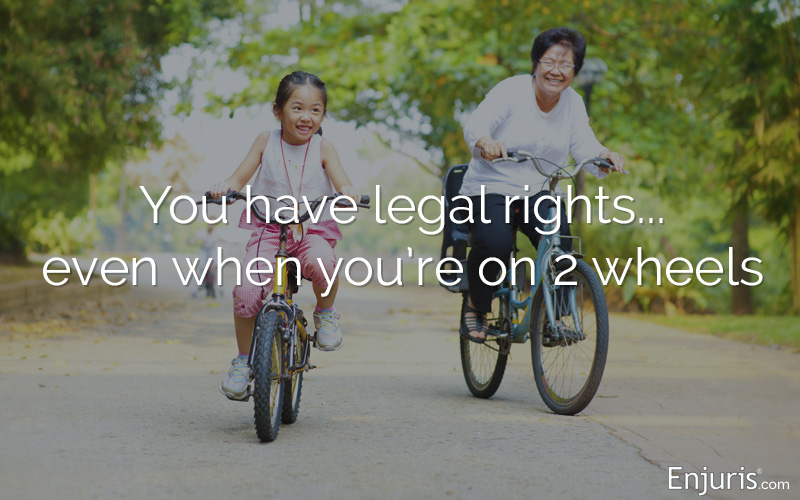
What to do after a bicycle crash or collision
When it comes to the most bike-friendly states, the League of American Bicyclists ranks Alabama 45th. The state’s poor ranking is due, in large part, to its lack of bike-friendly streets and laws favoring motorists.
Although its roads might not be the most hospitable, thousands of Alabamans choose to travel across the state on bicycles every day.
In this article, we’ll take a look at Alabama bike accidents, including the laws that impact bicyclists and how liability is determined following a bike accident.
Bicycle accident statistics
Alabama averages about 263 bicycle crashes every year. Most bicyclists involved in crashes are between the ages of 31 and 40.
| Alabama bicycle crash statistics (2015-2019) | |||
|---|---|---|---|
| Year | Bicyclists | Injuries | Fatalities |
| 2015 | 260 | 185 | 9 |
| 2016 | 290 | 214 | 4 |
| 2017 | 299 | 212 | 6 |
| 2018 | 277 | 209 | 9 |
| 2019 | 256 | 194 | 6 |
| Source: Alabama Department of Transportation (ADOT) | |||
Alabama bike laws
The Code of Alabama includes several statutes that address biking in the state. These statutes can largely be broken up into “rules of the road” and “bike safety laws”:
| Alabama rules of the road | Alabama bike safety laws |
|---|---|
|
|
Determining liability after a bike accident in Alabama
To recover damages after a bike accident, you need to prove that some other person (or entity) caused your bike accident.
Potential at-fault parties include:
- Motor vehicle drivers. Motor vehicle drivers have a duty to exercise reasonable care to avoid harming others on the road. If a motor vehicle driver fails to exercise reasonable care (e.g., the driver runs a red light) and causes your accident, you can file a personal injury lawsuit against them under the legal theory of negligence.
- Manufacturers. If your bike accident is caused by a defective bike part (such as improperly tightened wheel skewers), you can file a product liability lawsuit against the manufacturer.
- Property owners. Alabama premises liability laws require property owners to keep their property free from dangerous conditions. If you’re injured as a result of a dangerous condition (such as a large pothole), the owner of the property (often the town or city) can be held liable.
Although a lawsuit has yet to be filed, both the driver of the vehicle and the town responsible for maintaining the street light is likely to be sued.
It’s not always clear who’s at fault for an accident. In many cases, the bicyclist bears at least some of the blame.
So what happens when a bicyclist is partially at fault for an accident?
Alabama adopted the pure contributory negligence rule. This rule says that, even if the injured party (the bicyclist) was 1% at fault for the accident, the injured party is prohibited from recovering ANY damages.
If the rule sounds harsh, it’s probably because it is. Alabama is 1 of only 5 states to adopt the pure contributory negligence rule.
Does insurance cover a bike accident?
If a bicyclist is hit by a car, the bicyclist can file an insurance claim against the driver’s auto insurance policy (assuming the driver was at fault).
But what happens if a bicyclist causes an auto accident?
Most auto insurance liability policies will NOT cover an accident that you caused while riding your bicycle. As a result, anyone injured in such an accident will likely sue you personally for the damages.
How long do I have to file a bike accident lawsuit (statute of limitations)?
In Alabama, the statute of limitations for claims involving physical injuries is 2 years. That means you have 2 years from the date you suffered your injury to file your lawsuit. For claims involving property damage (for example, damage to your bike), you have 6 years to file your claim.
However, there are a couple of exceptions to the above statute of limitations. The wisest thing to do is meet with a personal injury attorney as soon as possible after the accident. The attorney can ensure that you preserve your legal rights.
7 steps to take after a bike accident
The steps you take following a bike accident could have a big impact on whether you’re able to recover damages for your injuries.
Here’s what you need to do:
- Step 1: Call an ambulance. Your health should be your top priority. Call an ambulance or have someone call one for you if necessary.
- Step 2: Call the police. Even if your accident seems minor, it’s a good idea to call the police. The police can conduct an investigation and draft a report that may help support your insurance claim or lawsuit. What’s more, the police can help you avoid a potentially dangerous confrontation with an angry driver.When the police arrive, make sure your version of events gets into the police report. If you’re feeling any pain whatsoever, be sure to tell the responding officer so they can make a note in the report.
- Step 3: Collect contact information. If it’s safe to do so, get the name, address, telephone number, driver’s license number, and insurance information of the driver. In addition, get the contact information for any witnesses at the scene of the accident.
- Step 4: Stick to the facts when talking to the driver. Avoid apologizing or admitting fault. Beyond making sure the driver isn’t hurt and exchanging insurance information, your communications with the driver should be minimal.
- Step 5: Preserve evidence. Be sure to take photographs of the scene if possible (road signs, weather conditions, skid marks, damage to your bicycle, physical injuries, etc.).Additionally, it’s a good idea to hold off on fixing your bike until your insurance claim or lawsuit is resolved. Similarly, preserve any clothes that might serve as evidence of the crash (bloody or torn shirt, etc.).
- Step 6: Document your injuries. After the accident, jot down your recollection of the crash while the details are still fresh in your mind.
It’s also a good idea to seek medical attention, even if your injuries are minor. Seeing your doctor soon after an accident is a good way to start a paper trail. It also helps prevent the insurance company or defendant from arguing that you weren’t actually hurt.
Post-Accident Journal Form
Sample accident journal/diary to help you document the effect on your daily life
Download in PDF format - Step 7: Contact a personal injury attorney. Most initial consultations are free, so you have nothing to lose by meeting with an attorney. A personal injury attorney can review your case and explain your legal options.
Ready to talk to someone about your bike accident? Contact an Alabama personal injury attorney near you using our free online directory today.
See our guide Choosing a personal injury attorney.


